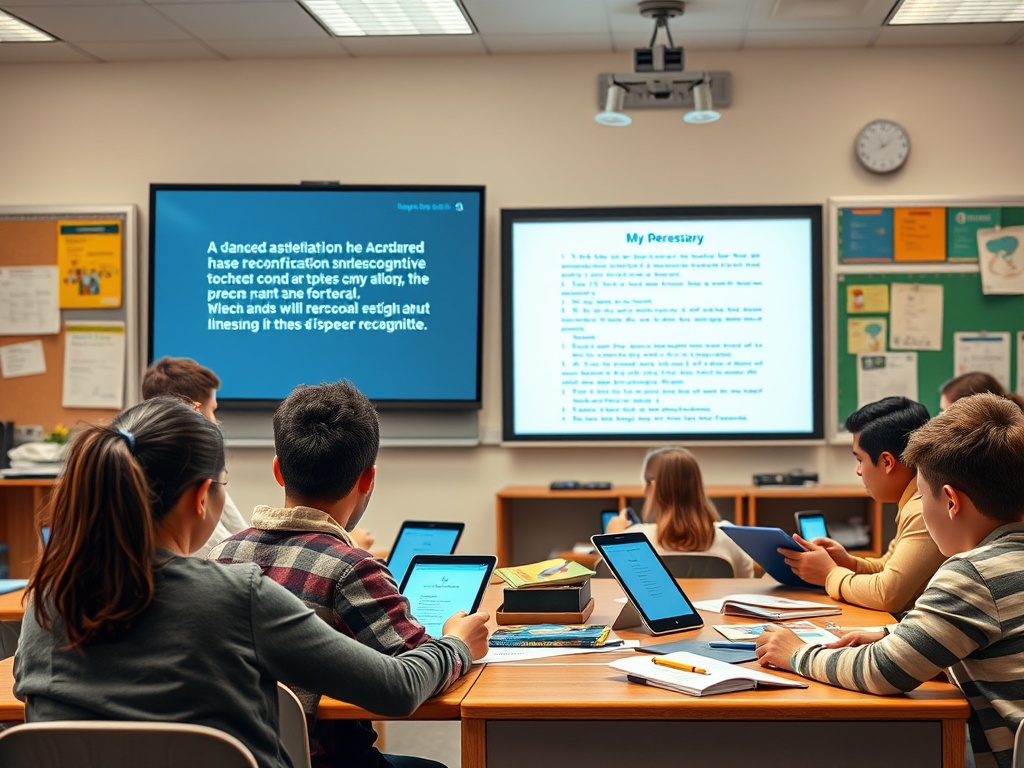Speech recognition is transforming education faster than most institutions expected. What started as an experiment in classrooms is now part of daily learning routines. Real time transcription, automatic subtitling, and language practice powered by voice input are increasingly common in universities, schools, and online platforms.
The numbers show why adoption is accelerating. Digital transcription has been shown to raise classroom participation by 25%. Accessibility for students with disabilities improves significantly, as documented by the National Center on Accessible Educational Materials. Accuracy rates of advanced tools are approaching the level of human transcription in controlled settings, which makes them practical in real classrooms.
This article explores how speech recognition is reshaping education, where it delivers clear benefits, what challenges remain, and how future developments may change teaching and learning worldwide.

Why accessibility defines the debate
Accessibility is the strongest reason behind adoption. Students with hearing impairments depend on transcripts and captions to participate fully. Speech recognition provides these supports in real time, creating equal access to lectures and group discussions. According to the CDC, more than 37 million adults in the United States have trouble hearing, which shows how critical these tools are.
For non native speakers, transcripts help revisit lectures and clarify difficult sections. Searchable text improves comprehension by allowing learners to locate explanations quickly. Educators benefit as well because the technology automates repetitive tasks such as attendance and lecture documentation.
Legal requirements also drive adoption. Accessibility regulations in higher education now expect captioning and transcription as baseline features. Institutions that ignore this face compliance risks and reputational damage.
Core applications already proving value
Lecture transcription
Real time lecture transcription allows students to focus on understanding rather than writing down every detail. Research shows that student engagement rises when transcription tools are active. Students can return to the text later, making the material more useful for revision.
Note taking support
Speech recognition reduces manual note errors by more than 30%. This accuracy gain means that students who struggle with writing can keep up with complex material. The shift benefits not only students with disabilities but the entire classroom.
Study material generation
Transcripts can feed into automated study aids. Applications convert text into flashcards, summaries, or keyword lists. Some systems already generate more than 80% of exam preparation flashcards automatically. This saves time and deepens engagement with content.
Video subtitling
In hybrid classes, automatic subtitles improve engagement by up to 30%. They make video learning inclusive for deaf students, hard of hearing students, and learners of English as a second language. Subtitles also help all students review complex lessons at their own pace.
Language learning tools
Pronunciation feedback in real time accelerates fluency. Apps such as Duolingo use speech recognition to guide learners in adjusting vowel and consonant sounds. Evidence shows that effective pronunciation assistance boosts retention by 30%.
These applications are already integrated into many universities, as reported by the Brookings Institution.

Research and data collection gains
Speech recognition is not only about accessibility in classrooms. It is also changing how academic research is planned, executed, and analyzed. Qualitative research often relies on transcribing long hours of interviews, oral histories, focus groups, or field observations. In the past, researchers either spent weeks typing recordings manually or paid for costly transcription services. Both options limited the scale of studies and slowed down analysis.
Automating transcription now reduces turnaround time dramatically. Many institutions report a reduction of transcription workload by 50% and a boost in coding efficiency of about 30%. This means that a study with 100 hours of interviews can be processed in days rather than weeks.
Enhancing data accuracy
Manual transcription is prone to human error, especially when large volumes of data are involved. Automated speech recognition reduces inconsistencies, making transcripts more standardized. Researchers can then apply coding frameworks with more confidence that key terms and recurring patterns are captured correctly. Search functions allow investigators to locate a phrase across hundreds of transcripts in seconds, something impossible with handwritten notes.
Supporting multilingual research
Modern research is often international. Projects may involve participants speaking different languages or dialects. Advanced speech recognition tools provide multilingual support, making it easier to produce transcripts in English or other target languages. This helps cross cultural studies and increases inclusivity in global projects.
Integration with analysis software
Many platforms now integrate directly with qualitative data analysis programs such as NVivo or ATLAS.ti. Researchers can import transcripts automatically, code them with tags, and run thematic analysis without repeated manual input. This seamless workflow saves time and improves the depth of findings.
Expanding research opportunities
Faster transcription opens opportunities for larger sample sizes. Small research teams can now collect and analyze far more data without exceeding budget or time limits. This makes academic projects more scalable and enables studies that were previously impractical.
Field applications
Beyond traditional interviews, speech recognition supports mobile data collection in the field. Anthropologists, sociologists, and public health researchers can record and transcribe on site conversations immediately. This prevents data loss and allows quicker reflection on research strategies.
Overall, these changes make academic projects faster, more cost effective, and still rigorous.

Benefits for teachers and administrators
Teachers and administrators often face heavy workloads that reduce the time available for direct student interaction. Speech recognition can relieve this pressure in several ways.
Automated attendance
Voice based attendance systems minimize human error and save minutes in every session. Instead of manually checking lists, a teacher can confirm presence through voice prompts, which are automatically logged. Over a semester, these small time savings accumulate into hours of regained teaching time.
Real time documentation
Classroom discussions and lectures can be recorded and transcribed instantly. Teachers can use these transcripts to plan future lessons, identify areas where students struggled, and build accessible archives of course material. Students benefit by revisiting these transcripts for revision, which reinforces learning.
Faster grading and feedback
Marking assignments and providing feedback is one of the most time consuming aspects of teaching. By dictating comments that are converted directly into text, teachers can respond more quickly. This allows for detailed personalized feedback without extending grading hours. Some institutions report noticeable reductions in turnaround times for returned assignments.
Administrative reports
Schools require constant reporting, from lesson plans to evaluation documents. Dictation tools powered by speech recognition allow educators to produce drafts quickly. This reduces paperwork stress and leaves more time for teaching and mentoring.
Stronger teacher student communication
When administrative burdens are reduced, teachers can devote more energy to direct communication. Real time transcription during office hours or group meetings ensures students leave with clear written notes of what was discussed. This transparency helps avoid misunderstandings and supports better academic performance.
Together, these applications create classrooms where teachers spend less time on repetitive administration and more time engaging with students, which is the core mission of education.

Supporting students with special needs
Students with special educational needs often face daily challenges in traditional classrooms. Tasks that seem routine for others, such as note taking or writing assignments, can become overwhelming when combined with the effort of following a lecture in real time. Speech recognition offers practical solutions that lower these barriers and support equal participation.
Helping students with dyslexia
Students with dyslexia may struggle to process written language quickly. This makes writing under time pressure particularly stressful. Speech to text allows them to dictate their thoughts fluently, focusing on ideas rather than spelling or handwriting. This shift supports better expression of knowledge and reduces frustration. Having an accurate transcript of lectures also means they can revisit lessons without the burden of decoding handwritten notes, improving comprehension.
Supporting learners with ADHD
For students with ADHD, switching attention between listening, writing, and staying focused is especially demanding. Real time transcription provides them with a reliable record of the lesson, so they can listen actively without worrying about missing details. Dictation tools reduce the cognitive load of typing assignments, enabling them to stay engaged longer. This combination often leads to stronger participation and increased confidence in classroom settings.
Enabling inclusive communication
Speech recognition does more than replace writing. It supports interactive tools that let students communicate ideas in different ways. For example, a student who finds traditional essay writing difficult can dictate their thoughts and then edit the transcript, making the process less overwhelming. This creates a more inclusive classroom where students with varied learning profiles can contribute on equal terms.
Personalized learning interfaces
Modern platforms adapt automatically to individual needs. Some systems allow users to adjust text size, highlight key terms in transcripts, or slow down playback of audio linked to captions. Others integrate with specialized tools for visual or auditory support. This personalization aligns with the principle of universal design in education, which seeks to make learning accessible to all students, regardless of their abilities.
Building confidence and independence
When students can complete assignments more efficiently, their confidence grows. Instead of feeling left behind, they see that they can keep pace with classmates. Over time, this reduces dependence on one to one assistance and builds greater independence in learning. Teachers also report that students who use speech recognition are more willing to participate in discussions, since they know transcripts will capture the details for later review.
Extending benefits beyond the classroom
The advantages continue outside of school. Homework, test preparation, and even daily communication become easier when students can rely on speech recognition tools. For parents and tutors, these technologies provide clearer insights into what students are learning and where they might need help. This continuity between school and home strengthens overall educational support.
In short, speech recognition empowers students with dyslexia, ADHD, and other learning differences to engage more fully, express themselves clearly, and build the skills needed for long term academic success. It is not just a technological aid but an inclusion strategy that transforms the educational experience.

Trends and forecasts
The next decade will bring deeper integration of speech recognition with artificial intelligence. Several trends stand out:
- AI powered personalization: Platforms will combine voice data with adaptive algorithms to create individual learning paths. Student sentiment and comprehension could be detected from spoken responses in real time.
- Multilingual transcription: Tools will provide instant translation and transcription across many languages, making global classrooms possible.
- Virtual teaching assistants: Real time speech recognition will support avatars and conversational systems that guide learners through tasks.
- Privacy first solutions: Institutions will demand stricter policies for storing and processing voice data. Edge computing and local processing may become standard.
- Integration into LMS: Learning management systems will embed speech recognition features directly, reducing reliance on third party tools.
- Stronger links with accessibility law: Governments will tighten rules on captioning and transcription, making adoption mandatory rather than optional.
- Data driven insights for teachers: Analytics based on voice interactions will help teachers identify struggling students faster.
- Cross industry use: Education will borrow solutions from healthcare and enterprise, where speech recognition has matured.
Current products such as the Graphlogic Speech-to-Text API and the Graphlogic Generative AI & Conversational Platform already show how these trends can take shape.

Rare but important details
Many schools overlook that speech recognition accuracy drops sharply in noisy environments. Microphone quality and classroom acoustics matter as much as the algorithm itself. Institutions planning adoption should invest in proper hardware alongside software.
Another overlooked detail is the importance of training students and teachers in using these tools. Without clear instructions, transcription services may be underused or misunderstood. Institutions that integrate workshops or short training sessions often see faster adoption and better results.
Practical tips for educators
Test tools before full deployment
Do not assume that a tool that works well in a demo will perform equally well in your classroom. Classrooms differ in size, layout, and background noise. Even the presence of fans, projectors, or outdoor traffic can reduce accuracy. Test the tool with actual students, record a real lecture, and evaluate whether the transcript matches the spoken content. Try several microphones and positions to see what setup delivers the clearest results. This process also helps identify how much editing is needed before transcripts are usable.
Combine transcripts with interactive tools
Transcripts are only the first step. The real value comes when they are transformed into flashcards, summaries, quizzes, or keyword lists. Students who use this layered approach often remember more because they engage with the material in multiple ways. Some universities already integrate transcripts with their learning management systems so that a student can highlight text and generate review questions automatically. Encourage students to treat transcripts as raw material for active learning, not as finished notes.
Encourage review after lectures
Cognitive research shows that repetition soon after learning improves retention. Ask students to revisit transcripts within 24 hours. Simple practices like underlining unfamiliar terms or adding annotations help reinforce memory. Provide guidance on how to use transcripts effectively, for example by creating summaries or mapping out key arguments. When review becomes a structured habit, comprehension increases and exam performance improves.
Use speech recognition for administrative work
Administrative tasks can consume hours each week. Automating attendance through voice input saves minutes in every class and ensures accurate records. Teachers can also dictate quick notes during class that are stored automatically for later use. During grading, dictation can speed up written feedback and reduce the repetitive strain of typing. Schools that adopt this approach often report more time for direct interaction with students.
Protect student privacy
Voice data can reveal sensitive information. Before adopting a tool, check the vendor’s compliance with national and institutional privacy regulations. Ask whether data is stored locally or in the cloud, how long it is kept, and whether it is used for training algorithms. Communicate clearly with students and parents about these policies. Transparency builds trust and ensures that the adoption of speech recognition does not create hidden risks.
Provide clear training
Technology that is poorly understood often goes unused. Run introductory workshops for teachers to practice dictation, transcription, and review features. Offer students simple guides on how to highlight, annotate, and export transcripts. Consider creating video tutorials so that anyone can revisit instructions. The investment in training pays off in consistent use and higher satisfaction.
Apply universal design principles
A transcript benefits not only students with disabilities but also those who learn better through reading. Offer both captions and full transcripts so each student can choose what supports them best. For auditory learners, pairing transcripts with audio playback creates a multimodal approach. Universal design principles ensure no student is excluded and that classroom materials are flexible enough to meet diverse needs.
Invest in reliable hardware
Even the best software cannot fix poor audio input. Equip classrooms with directional microphones that reduce background noise. Test internet connections to avoid interruptions during real time transcription. Consider portable solutions for fieldwork or off site classes. Investing in reliable hardware at the start prevents frustration and avoids the perception that speech recognition is unreliable.
Set realistic expectations
Educators should frame speech recognition as a support tool, not a complete replacement. Note taking teaches students to summarize, filter, and organize information, which are critical academic skills. Make it clear that transcripts are a supplement for review and accessibility, not a shortcut that eliminates active learning. When students understand this balance, they benefit more and avoid over reliance.
Monitor outcomes and collect feedback
Every classroom is different, so measure impact continuously. Track whether participation improves, whether students with disabilities feel more included, and whether comprehension scores increase. Collect anonymous surveys after each semester to capture honest feedback. Use this data to adjust how speech recognition is integrated. For example, some classes may need edited transcripts, while others may be comfortable with raw automated text.
Promote collaborative learning
Encourage students to create shared study guides from transcripts. Groups can divide sections, summarize them, and compare results. This collaborative approach reduces duplication of effort and builds peer support. Shared documents also provide a collective record of class discussions, which can help absent students catch up. Collaborative work turns speech recognition into a community tool rather than just an individual one.
Prepare contingency plans
Technology sometimes fails. Microphones can disconnect, internet services can go down, or transcription engines may lag. Always have backup methods ready, such as human note takers, recordings, or pre prepared materials. Communicate contingency plans to students so they know what to expect. This ensures that accessibility commitments are upheld even during disruptions and reinforces confidence in the technology.
Conclusion
Speech recognition is now one of the most important tools in modern education technology. It improves accessibility, enhances learning efficiency, and reduces teacher workload. Its applications extend from classroom transcription to language learning, research support, and administrative tasks.
Challenges remain in accuracy, privacy, and over reliance, but the benefits outweigh the risks when adoption is careful and responsible. With the rise of AI powered systems, the future will bring even more personalized and global learning opportunities.
Institutions that embrace these tools with clear strategies will not only meet accessibility standards but also create more engaging and inclusive education environments.
FAQ
Accuracy is now approaching human levels in controlled conditions. Noise and accents can still reduce quality, but consistent improvement in algorithms means the gap is closing quickly.
It should not. Note taking is a valuable skill. The technology is best used to complement student notes and provide a reliable backup.
It provides real time captions, reduces manual writing pressure, and enables voice input for assignments. This levels the playing field for many learners.
Institutions must check where data is stored and how it is processed. Solutions that offer local processing or comply with strict privacy standards are recommended.
Costs are falling as adoption grows. Cloud based services often provide pay as you go models, making them accessible even for smaller institutions.

